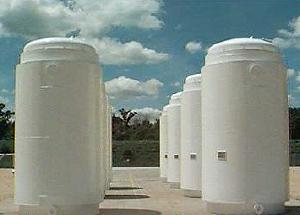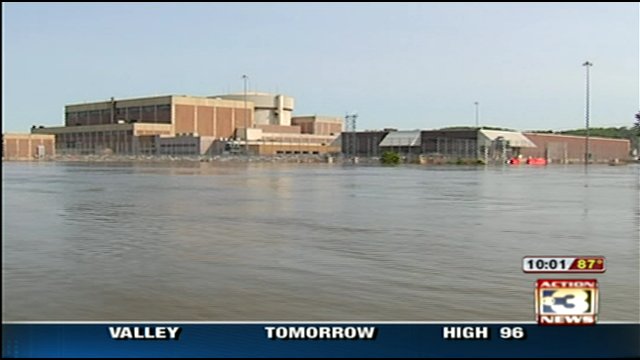Another Allis nuclear plant
March 8th, 2012
Alan’s been digging around looking at the old nuclear demonstration plants, particularly since my father worked on the Elk River plant in Minnesota, now decommissioned. and lo and behold, Genoa is/was another Allis-Chalmers nuclear plant, although it’s a different branch of the family:
How bizarre…
And now for something a little more current:
Don’t forget that our Monticello GE reactor is similar to Fukushima reactors. Enough about upgrades – SHUT THEM DOWN!
Nuclear Waste in Minnesota Granite!
December 27th, 2011
Thanks to a reporter (THANK YOU THANK YOU THANK YOU!!!), I’ve got the recently release Sandia report:
Granite Disposal of U.S. High-Level Radioactive Waste – Sandia National Laboratories
This was released in August 2011. It’s making the rounds now.
Here’s the part that really scares me, right there on the first page:
Unlike the safety analyses for disposal in salt, shale/clay, or deep boreholes, the safety analysis for a mined granite repository depends largely on waste package preservation. In crystalline rock, waste packages are preserved by the high mechanical stability of the excavations, the diffusive barrier of the buffer, and favorable chemical conditions. The buffer is preserved by low groundwater fluxes, favorable chemical conditions, backfill, and the rigid confines of the host rock. An added advantage of a mined granite repository is that waste packages would be fairly easy to retrieve, should retrievability be an important objective.
Yes, it’s on page one (do I even want to read past page one? NOOOOO). What’s scary about that? Well, back in “Nuclear Waste Daze” representing Florence Township, I learned more than I wanted to know about “waste package preservation,” specifically a lot about weld flaws, about loading “ignition events”because they hadn’t considered the impacts of zinc and boric acid:
On May 28, 1996, a hydrogen gas ignition occurred during the welding of the shield lid on a ventilated storage cask (VSC-24) multi-assembly sealed basket (MSB). The gas ignition displaced the shield lid (weighing about 2898 kilograms [6390 pounds]), leaving it in place but tipped at a slight angle, with one edge about 7.6 centimeters [3 inches] higher than normal.
The loaded VSC-24 multi-assembly transfer cask (MTC), a shielded lifting device used to transfer the MSB loaded with spent fuel to the ventilated concrete cask, had been placed in the cask decontamination work area in the auxiliary building. Approximately 114 liters [30 gallons] of borated spent fuel pool water had been drained from the MSB to facilitate welding of the shield lid, creating an air space below the lid. The hydrogen gas ignition occurred during the initiation of the shield lid welding, approximately 11 hours after the loaded MTC had been removed from the spent fuel storage pool.
And then there’s the inability to unload a cask once it’s been loaded and used for storage for a while. for a Three Stooges HILARIOUS (if the truth wasn’t so scary) report on trying to unload a cask, “oops, an assembly is warped, oops, got stuck pulling out, oops, what to do, oops, let’s just ram it back in and put the cover on” at INEL:
The possibility of revival of the notion of storing nuclear waste in the Minnesota granite, and granite anywhere, is more than I want to think about.
Here’s a fun video with some shots that Northern States Power showed us back in the NSP sponsored “Task Force” prior to their application(we’re talking late 1994-early 1995 here), to show us how safe casks are:
Homer, you work at a nuclear plant – what do you think?
Ft. Calhoun nuclear plant flood and fire
June 8th, 2011
Remember the flooding info and maps I’d posted a couple of days ago, noting that two nuclear plants in Nebraska were in the flood inundation area?
Well, Frieda Berryhill sent this photo of the flooding at the Ft. Calhoun nuclear plant:
Check the video, Omaha Public Power District – OPPD didn’t want the news crew filming the flooding!!! And thankfully, they reported that point:
As if the flooding isn’t enough, they had an electrical fire, and shut down the spent fuel pond pumps to aid in fighting it. There are many articles posted on this, all the IDENTICAL AP article, and not one mention of flooding:
Here’s a local paper with some additional details:
Omaha Public Power District’s release on the flood:
OPPD Declares Notification of Unusual Event
More on Fukushima nuclear disaster
April 8th, 2011
Another Fukushima Daiichi update
March 30th, 2011
The nuclear mess in Japan is just slowly getting worse, with radiation leaking out at higher levels, more radioactive water from the plant leaking out, nowhere to store what they are able to pump out, and efforts to pump water in aren’t sufficient to provide cooling. The good news is that they are finally openly admitting that the plants will have to be “scrapped.”
Here are some updates from around the world:
Japan may have lost race to save nuclear reactor
Japan nuclear crisis: evacuees turned away from shelters
Here’s a view of our own Monticello reactor, the same GE as some of the Fukushima plants:
For some technical info and photos of this type of GE reactor, check this “Virtual Nuclear Tourist” site, put together by Joseph Gunyeau (here’s some background on him) who I think is based in nearby Cannon Falls, he has been a contractor at many nuclear plants — and he says that a Fukushima page is in the works:






